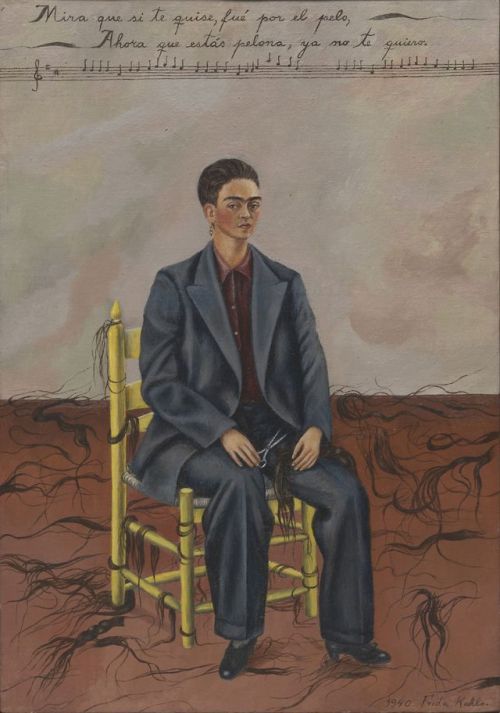Although best known for her elaborate self-presentations as an iconic Tehuana woman, Kahlo also cons
Although best known for her elaborate self-presentations as an iconic Tehuana woman, Kahlo also constructed and performed alternative versions of herself. She focused on her clothing, hair styling, and accessories to fashion diverse, complex — and at times contradictory — identities for herself, including her gender. In “Self-Portrait with Cropped Hair,” we see an example of such an act of self-transformation from Tehuana (whose braids and loose hair litter the ground) to an alternative androgynous being.Posted by Rachel LewisEmmy Lou Packard (American, 1914—1998). Frida Standing AgainstWall, 1941. Gelatin silver print. Courtesy of Throckmorton Fine Art ⇨ Frida Kahlo (Mexican, 1907-1954). Self-Portrait with Cropped Hair, 1940. Oil on canvas. Museum of Modern Art, Gift of Edgar Kaufmann, Jr. © 2019 Banco de México Diego Rivera Frida Kahlo Museums Trust, Mexico, D.F. / Artists Rights Society (ARS), New York. (Digital Image © The Museum of Modern Art/Licensed by SCALA / Art Resource, NY)A pesar de ser conocida por sus autorrepresentaciones como una icónica mujer tehuana, Kahlo elaboró y presentó versiones alternas de sí misma. Se concentró en su vestuario, peinados y accesorios para construir complejas —y por momentos contradictorias— identidades, incluyendo su género. En “Autorretrato con pelo cortado” vemos un ejemplo de un acto de autotransformación, de mujer tehuana (cuyas trenzas y pelos sueltos están esparcidos por el suelo) a un ser andrógino alternativo. -- source link
Tumblr Blog : brooklynmuseum.tumblr.com
#fridakahlobkm#brooklyn museum#frida kahlo#dress#fashion#hair#style#acessories#contradictory#identity#gender#cropped hair#braids#gender fluidity#art

